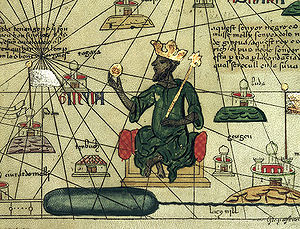Gold Money Inflation in Egypt...
Musa (Mansa)
Mansa Kankan Musa[1] was the tenth mansa or emperor of the Mali Empire during its height in the 14th century. He ruled as mansa from 1312 to 1337. Musa is most noted for his 1324 hajj to Mecca and his role as a benefactor of Islamic scholarship.

Musa depicted holding a gold nugget from a 1375 map of Africa and Europe.
Birth
Mansa Musa's birth date is not known. Oral histories recount he was the grandson of Mansa Abubakari I, Sundiata Keita's half-brother.[2] Musa's father was a prince named Faga Laye, who never attained the title of mansa.
Hajj
In the 14th year of his reign (1324), he set out on his famous pilgrimage to Mecca. It was this pilgrimage that awakened the world to the stupendous wealth of Mali. Traveling from his capital of Niani on the Upper Niger River to Walata (Oualâta, Mauritania) and on to Tuat (now in Algeria) before making his way to Cairo, Mansa Musa was accompanied by a caravan consisting of 60,000 men including a personal retinue of 12,000 slaves, all of whom were clad in brocade and Persian silk. He also brought with him 80 to 100 camels loaded with 300 pounds of gold each. The emperor rode on horseback and was directly preceded by 500 slaves, each of whom carried a four-pound staff of solid gold.
Musa's lavish clothing and the exemplary behavior of his followers created a favorable impression among the peoples his caravans encountered. The Cairo that Mansa Musa visited was ruled over by one of the most powerful of the Mamluk sultans, Al-Malik an-Nasir. The emperor's noted civility not withstanding, the meeting between the two rulers might have ended in a serious diplomatic incident, for so absorbed was Mansa Musa in his religious observances that he was only with difficulty persuaded to pay a formal visit to the sultan.
The historian al-'Umari, who visited Cairo 12 years after the emperor's visit,[3] found that the inhabitants of this city - with a population that approached one million residents - still spoke in reverential tones about Mansa Musa. So lavish was the emperor in his spending that he flooded the Cairo market with gold, thereby causing such a decline in its value that, over a decade later, the value of specie had still not fully recovered. [4]
en.wikipedia.org
P.S.
During this period, there was an advanced level of urban living in the major centers of the Mali Empire, especially in comparison with the relative backwardness of much of Europe. Sergio Domian, an Italian art and architecture scholar, wrote the following about this period: "Thus was laid the foundation of an urban civilization. At the height of its power, Mali had at least 400 cities , and the interior of the Niger Delta was very densely populated." [5] |





